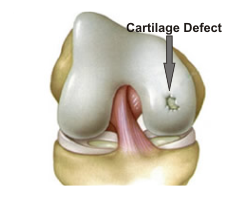
Articular cartilage is the smooth, white tissue covering the ends of the bones, allowing the bones to glide over each other with little friction. This cartilage can be damaged by injury or wear and tear.
Patients with joint injuries like meniscal or ligament tears can also lead to cartilage damage.

Treatment
The cartilage defects are normally treated using surgical interventions but the doctor might start off with non-surgical treatment options
Non-Surgical Treatment- FOR smaller defects in non articulating area, bracing and conservative treatment will help .
Surgical Treatment
There are different surgical procedures that are performed to restore the articular cartilage. Most of them are performed using Arthroscopy or keyhole surgery. During Arthroscopy, the surgeon makes tiny incisions around the joint and then inserts a tiny camera connected to an external viewing monitor. The surgeon makes use of the arthroscope to view the affected area. The surgeon will then insert long and thin specialized medical instruments and guide them to the injured area using the arthroscope and then perform the repair.
There are different procedures that are used for cartilage restoration. Some of the most common ones are:
Stem Cells and Tissue Engineering
There is research being conducted that focusses on the body to grow healthy cartilage tissue, called Tissue engineering. In this process, the growth factors that can stimulate new tissue are isolated and used to induce new cartilage formation.
Stem Cells are extracted from living human tissues like bone marrow, and then placed in a specific environment. They start to transform themselves into cells similar to the host tissue. By reinjecting the stem cells near a damaged joint surface will stimulate them to produce new healthy cells similar to the joint tissue.
Your doctor will suggest the best suitable type of procedure for you depending upon the size and location of the cartilage defect .
Testimonials

Last one year I was suffering from acute shoulder pain on my left shoulder. I went to several doctors, but not diagnosed.